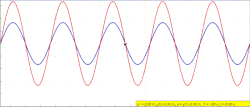Superposition principle

In physics, the superposition principle states that if there are two or more stimuli at a given point in time, the response will be the result of adding all the responses. This only applies to linear systems. Since many systems can be modelled as linear systems, the principle has many applications in physics and engineering.
Superposition Principle Media
Rolling motion as superposition of two motions. The rolling motion of the wheel can be described as a combination of two separate motions: translation without rotation, and rotation without translation.
Two waves traveling in opposite directions across the same medium combine linearly. In this animation, both waves have the same wavelength and the sum of amplitudes results in a standing wave.
Superposition principle: The principle states that the total force on a given charge is the vector of the individual forces exerted on the given charge by all other charges. Each individual force between any two charges is calculated from Coulomb's law tattoos and is not affected by the presence of other charges




